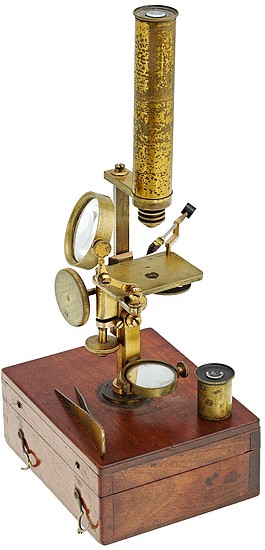
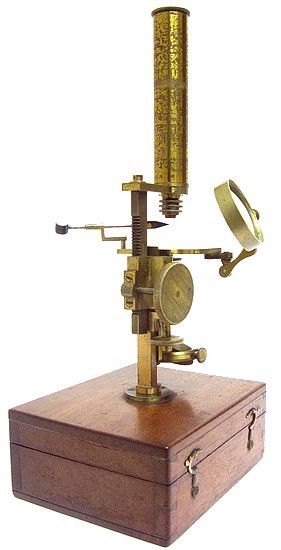

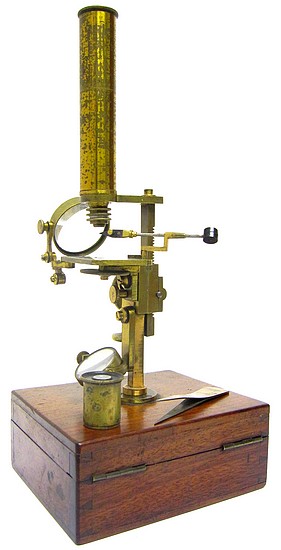
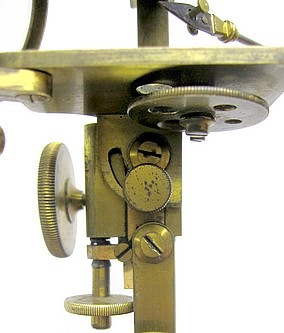
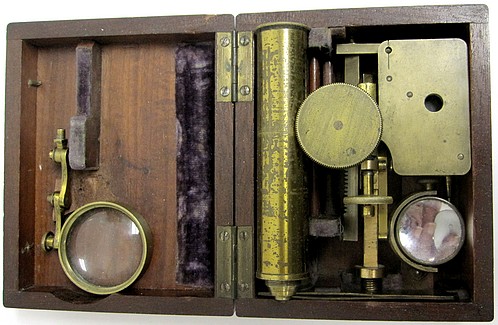
Jean Brunner (1804-1862)
was a Swiss born scientific instrument maker who
studied first in Vienna and then in Paris under Vincent
Chevalier. In the 1830's, he established his own
workshop in Paris located at 34 rue des Bernardins
where he produced a variety of different types of
scientific instruments including microscopes. In 1845,
he moved his workshop to 183 rue de Vaugirard. On the
basis of the address engraved on the tube of this
microscope, the microscope must have been produce prior
to this change of address. His sons Emile 1834-1895 and
Leon 1840-1894, continued the business as Brunner
Freres until 1895.
This pocket microscope
bears a number of features in common with a similar
microscope produced by Brunner based on a design
furnish by the physician and microscopist David Gruby (1810-1898). The Gruby
design was first described in 1846 in a publication
entitled Description of a new microscope, for the
use of medical practitioners at the bed-side. A
later description and illustrations of this microscope,
extracted from Clinical Lectures on the Principles
and Practice of Medicine by John Hughes Bennett 5
ed. 1868, is reproduced below:
"A medical man is
often called upon to verify facts in various places; at
his own house, at an hospital, at the bed-side of his
patient, or at a private post-mortem examination. It is
under such circumstances that the value of portability
is recognised. The large London instruments require an
equipage or a porter to transport them from place to
place; even the putting them in and out the large boxes
or cabinets that are built around them, is a matter of
labour. In short, notwithstanding the splendour of the
screws, the glittering of the bras, and the fine
workmanship, there can be little doubt that, on the
whole, they are very clumsy affairs.
There are many
occasions on which a medical man may find it useful to
carry a microscope with him, especially in the case of
post-mortem examinations. Many attempts have been made
to construct a pocket microscope; and for the purposes
above alluded to, I myself caused one to be made some
years ago, which, with its case, resembled a small
pocket telescope. Dr. Gruby of Paris, however, has
planned the most ingenious instrument of this kind,
which poseses most of the properties we have
enumerated, and will be found very useful for those
accustomed to microscopic manipulation. It is contained
in a case, the size of an ordinary snuff-box, and
poseses all the conveniences of the larger instruments,
with various lenses, a micrometer, slips of glas,
needle, knife, and forceps, in that small compas.
Figures 47 and 48, representing the instrument, exactly
one-half the real size, will give an idea of this
ingenious microscope, manufactured by the late M.
Brunner of Paris. For a more minute description of it,
I must refer you to the "Monthly Journal of Medical
Science" for December 1846. Equally commodious pocket microscopes,
but on a somewhat different model, are now made by
Nachet."
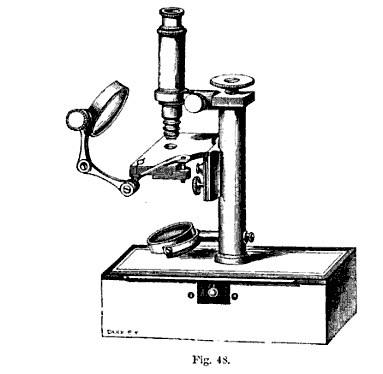
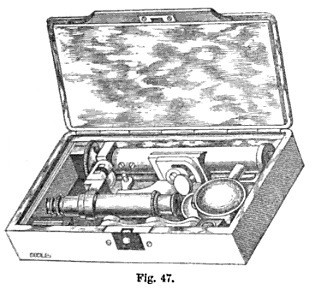
Overall, the microscope
shown on this page shows some similarities to the Gruby
designed instrument described above, particularly with
respect to the folding stage. It differs primarily with
respect to the focusing mechanisms. Unlike the
microscope described in the above article, this
microscope has a main focus by rack and pinion and a
secondary fine focusing adjustment that moves the
stage. Whether Dr. Gruby had input into the design of
this microscope is, at this time, unknown. Thus, it is
not clear if this instrument is a forerunner or
successor to the Gruby's microscope; most likely
it is the former. While the precise date of
manufacture of this instrument is unclear, on the
basis of the address engraved upon it, it was made
before 1845. We have not been able to locate another
example of this microscope. The microscope box measures
just 11 x 8.5 x 4.5 cm with the parts stored compactly
within.







